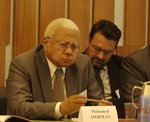Mohamed OTHMAN
contribution 28 -
OTHMAN Mohamed

original version
One of the issues that was raised was about the whole question of pre and post custody trial delays and the actual delays in the model of criminal justice. I don’t think that we necessarily must accept that the Arusha model is a model that seconds delayed justice. There are a number of reasons why I say so. I think that, as a premise, we cannot, coming from different background, human rights and so on, accept that international criminal justice is a delayed model of delivering justice. For a number of reasons.
I think we must accept that international criminal justice offers the highest standard of criminal justice but not that it offers a delayed justice. Although the reality, as I say, is something that one must improve. There is, I think this was mentioned, the example of the forthcoming case of Butare. Between the time of the arrest and custody of the accused in the hands of the Tribunal to the delivery of the judgement there will be 13 and a half years in the Butare case, and there are other examples. But we have to look in the reasons for this delay, because if you look in most of the cases, the actual number of trial days is not that many years, and this is the same situation in the Yugoslavia tribunal.
The Milosevic case is 466 days of trials. He was in custody for four years. Even in the Butare case, for example, which would be one of the longest, 13 and a half years, the number of trial days were probably not more than two years. We have to look at what happened to the remaining 11 years. And that is where you find the solution. What happened to the remaining 11 years of the Butare case or any other case? And for the reasons you have to look into different okay, not necessarily to go into the national system, because national system for dismissal of a case for abuse of process ranges, you know, sometimes even two years in some jurisdictions. But within the Tribunal, I think the fault, and we have to accept, we said about humility, the Prosecution contributes, the Defence definitely contributes, and the Chambers have some responsibility for that. I don’t want to list down, but there are so many. Translation I think was said was one. The question of joint trials is debatable. Clearly when you have a single trial, a joint trial of six accused, how long it takes? That was one issue. Witnesses, disclosure obligations, amendments of indictments, change of Defence counsel at the 11th hour. Those things have happened throughout these many years.
So I think that when we want to move forward, we have to say that we accept that the model we are looking for, the ideal model from the experience from Arusha is that we have to move from a model that has resulted into long trial to a model that will offer the highest standard of criminal justice, but bring it about reasonably. I don’t think that it is possible to try crimes of this nature . The difference is very simple to ordinary crime, because here, for example, in every indictment you have basically two company. One company is the context. Proving the context is itself a very, very considerable bulk of the evidence goes to prove the context. Until now, after ten years, you have judicial notice on the genocide, but before that it has to be proved. I don’t think this question of proof of the genocide has to be jumped. So proving the context is as much laborious as proving the individual guilt of the accused person. And that is why in proving the context we have relied on expert witnesses, documentary evidence, and so on and so forth.
But I think that the experience of Rwanda Tribunal shows that all the parties are working towards reducing the delays. I think the efforts of the Chambers also in that regard in terms of better case management and so on and so on and so forth. Thank you.

